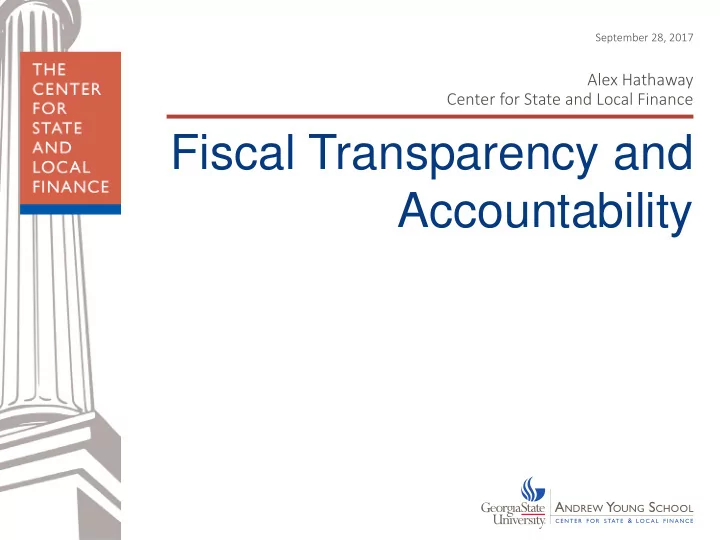

September 28, 2017 Alex Hathaway Center for State and Local Finance Fiscal Transparency and Accountability
Overview • Importance of Institutional Transparency • Review of the Literature • Methodology – Volcker Alliance questions – Detecting structural deficits • Results – Explicit structural deficits – Multi-year revenue/expenditure forecasts – Other long-term liabilities 2 Alex Hathaway
Why the need for more transparency in government? • Principal-agent problem – Voters as principals have needs/wants – Government as agent addresses needs/wants through policy • Fiscal illusion – Something-for-nothing policies • Push costs into future • Devolve costs to other entities 3 Alex Hathaway
Review of the Literature • Benefits – Improved accountability, trust, and fiscal performance – Reduced corruption • Drawbacks – Misinterpretation of information – Vulnerability to interest groups • Measurement tools – Open Budget Index (OBI) • Best Practices – OECD, IMF 4 Alex Hathaway
Best Practices Guidelines IMF MF OEC ECD • Budget should be timely and • Clear institutional framework show economic assumptions, • Budget preparation guided by detailed commentaries on transparent macroeconomic/ revenue/expenditure fiscal policy objectives programs, and performance • Information should be targets accessible and understandable • Include specific disclosures to promote accountability – Tax expenditures, assets/liabilities, pensions • Timely publication Integrity, control, accountability • • External scrutiny for accuracy – Accepted accounting practices and accepted quality standard – Freely available to public online Code of Good Practices on Fiscal Transparency, IMF, 2007. Best Practices for Budget Transparency, OECD, 2002. 5 Alex Hathaway
Methodology • Volcker Questions: Timely & Complete Information – Structural Imbalance; Multi-year Forecasts; Long-term Liabilities • Accessible for an Average Citizen – Google search – In executive proposal, appropriations act, supporting executive/legislative documents • Understandable for an Average Citizen 6 Alex Hathaway
Results: Structural Imbalance 13 states disclose this: Alaska, Arizona, California, Connecticut, Illinois, Maryland, Massachusetts, Minnesota, New York, North Carolina, Rhode Island, Washington, West Virginia 7 Alex Hathaway
Mar aryla land Wes est V Virgi ginia State of West Virginia — FY 2017 Executive Budget Report State of Maryland — FY 2016 Interim Report of the Spending (Volume I), p.12 Affordability Committee, p.35 8 Alex Hathaway
Calif lifornia ia State of California — The 2017-18 Budget: California’s Fiscal Outlook, p.52 9 Carolyn Bourdeaux
Results: Multi-year Forecasts Includes forecasting for revenues, expenditures, • major programs (Medicaid/education), and tax expenditures 5 states produce multi-year tax expenditure • forecasts: California, Minnesota, Pennsylvania, T exas, • and Washington Ease o of l locati ting fo g forecasting g documents metric: 1. . Information can be easily found through Google search of "[state] [topic keywords]" (e.g., "Florida revenue forecast"); search results link directly to document with the information or to related page where document can be easily found Keywords: revenue forecast, expenditure forecast, debt service, retirement pension, retirement OPEB, deferred maintenance/repairs, tax expenditure/break/abatement, public education/Medicaid revenue/expenditures 2. 2. Information is in the budget/related documents but requires searching executive/legislative websites or detailed search of budget; an average citizen could locate it 3. Information is in the budget/related documents but difficult 3. to find or requires expert knowledge 10 Alex Hathaway
Results: Multi-year Forecasts 15 states have all three: Alaska, Arizona, California, Connecticut, Florida, Hawaii, Illinois, Minnesota, New York, Pennsylvania, Rhode Island, South Carolina, South Dakota, Virginia, West Virginia 11 Carolyn Bourdeaux
Florida’s Major Program Evaluation Key Budget Driver Worksheet, Long-range Financial Outlook, FY16/17 through FY18/19, Fall 2015, p.73. Totals added from p.74. 12 Alex Hathaway
Results: Long-term Liabilities Debt affordability/capacity • studies often provide future estimates of long-term liabilities 28 states release them • Can be difficult to find • May not be produced • regularly 21 states list the upcoming fiscal • year’s debt service costs. Massachusetts includes pension • and OPEB ARC requirements for the upcoming year in budget documents. Alaska and Hawaii produce • comprehensive deferred maintenance reports for less than three future years 13 Alex Hathaway
West Virginia 14 Alex Hathaway
Connecticut 15 Carolyn Bourdeaux
Conclusions • Every state has room to improve its transparency practices • Many states have underfunded pension/OPEB obligations but do not consider future burdens • To see structural imbalances more easily, a single multi- year forecast should include: – Revenues/expenditures/long-term liabilities – Methodology and discussion about imbalances and potential solutions • Future Research – Political acceptability, fiscal stability of single forecast 16 Alex Hathaway
Recommend
More recommend